Recent Mold Remediation Posts
Types of mold in Wyoming
2/6/2019 (Permalink)
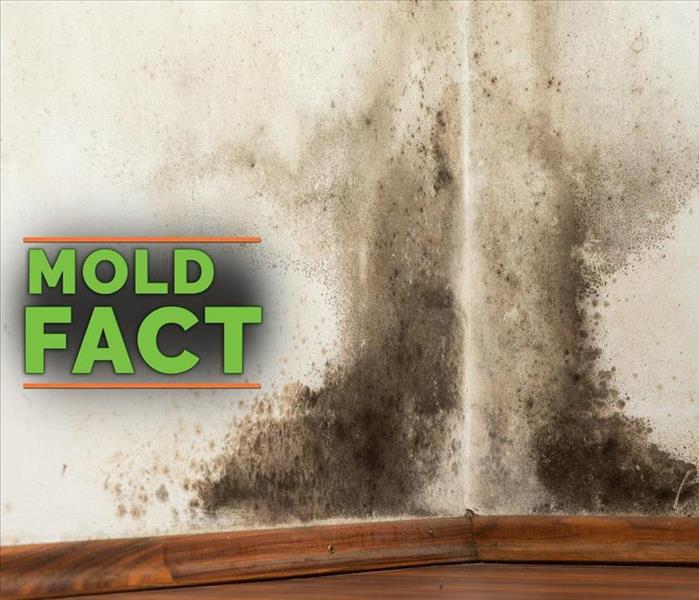 Moldy Wall
Moldy Wall
The various species of mold that can grow in a home or business can vary from region to region. Certain varieties of mold may be more common in the Southern parts of our country, but rare in Northern regions. In the Rocky Mountain region, the most common mold types found in homes are Cladosporium, Penicillium, and Aspergillus. Stachybotrys, often referred to in the media as “the black mold”, can occur in Wyoming, though it is not as common.
The only way to determine what species of mold is present in your home or commercial property is through testing by a qualified Indoor Environmental Professional (IEP). Through a series of air sampling and/or surface sampling, an IEP can determine what molds are present in your home, and the levels of concentration. They can also write a mold remediation protocol, detailing precisely what steps need to be performed in order to effectively correct the mold issue in a home or business.
The professionals at SERVPRO of Casper are certified and highly-trained in mold remediation and removal. We carefully follow written IEP protocols to remediate the problem in your property, and bring it back to a safe, normal state.
Air Scrubbers on mold clean up
1/11/2019 (Permalink)
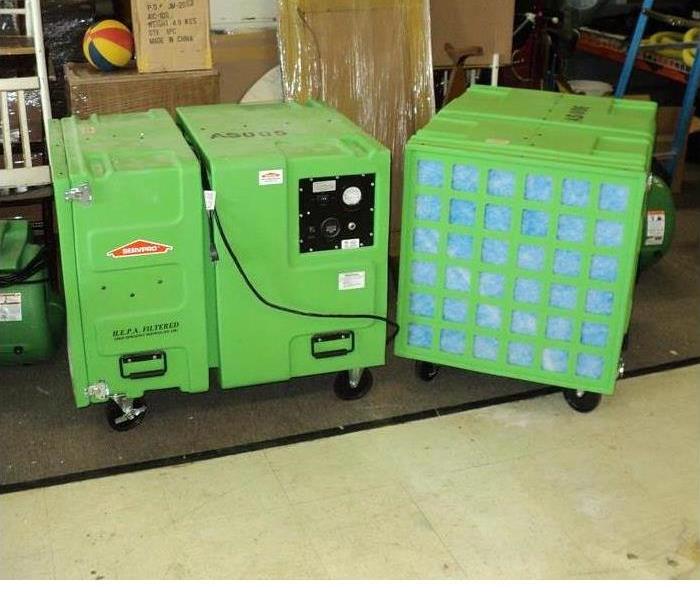 Air Scrubber
Air Scrubber
Air scrubbers, also known as air filtration devices, are used on various types of clean up projects. We use air scrubbers on mold remediation, sewage clean ups, drywall removal, and deodorization jobs. The purpose of the air scrubber is to help filter out the air of the fine particles that you can’t see. As air passes through the machine, it traps airborne particulate in the filters, releasing clean air back into the area. The critical component of an air scrubber is the high efficiency particulate air (HEPA) filter. The HEPA filter captures 99.97% of particles down to a size of 0.3 microns. (For reference, a micron is approximately 1/100th the width of a human hair.) The filtered air is very clean, and essentially free of mold spores and dust.
Steps for Mold Clean Up in Casper, WY
8/15/2018 (Permalink)
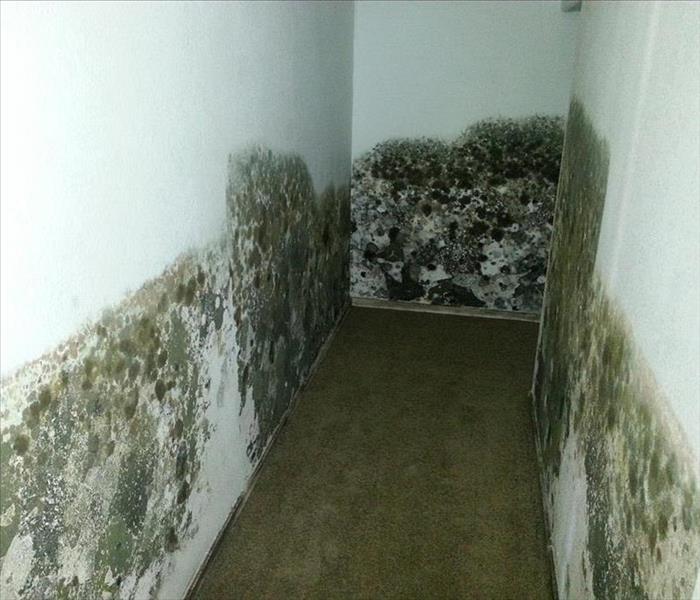 Moldy walls all the way down the hall.
Moldy walls all the way down the hall.
If you notice musty odors in your home, or discover damage that appears to be mold, you should definitely have a professional look at it. A visual inspection from SERVPRO of Casper can help identify what caused the damage, and what needs to be done to correct it.
Sometimes, we may recommend that you have an Industrial Hygienist perform testing. While home mold test kits are a popular, inexpensive purchase at local hardware stores, they are inadequate for proper mold assessment. An Industrial Hygienist is an expert in Indoor Air Quality, and is properly trained to collect samples and analyze them. Once the analysis is done, an Industrial Hygienist writes a mold remediation protocol, detailing the exact steps required to effectively remove the mold. Armed with this information, the professionals at SERVPRO of Casper can perform remediation services to bring your home or business back to a normal state.
Safety Tips on How to Handle Mold
7/13/2018 (Permalink)
 Safety Tips on How to Handle Mold
Safety Tips on How to Handle Mold
If you see visible mold or think you have mold in a room of your home, there are some measures you should take to keep it from spreading.
Things to do:
- Call a Certified Industrial Hygienist (CIH)
- Stay out of the affected room
- Turn off the HVAC system in that room
Things not to do:
- Don’t disturb the mold
- Don’t blow air in the area
- Don’t spray bleach or other cleaning products
SERVPRO of Casper specializes in mold remediation. We have technicians that are IICRC (Institute of Inspection of Cleaning and Restoration) certified specifically as AMRT (Applied Microbial Remediation Technicians).
If you have any concerns that you may have mold, call SERVPRO of Casper before buying the “do-it-yourself” mold testing kits from the hardware store. These kits typically involve a swab and a Petri dish. Because normal environments always contain a small amount of mold spores, using them will always end with a “positive” test result, even if there is no real problem in your home. A visual inspection by the professionals at SERVPRO, coupled with testing performed by a qualified CIH will give you accurate answers, and a plan to properly take care of any microbial problems you may have.
Moldy Crawl Spaces
7/10/2018 (Permalink)
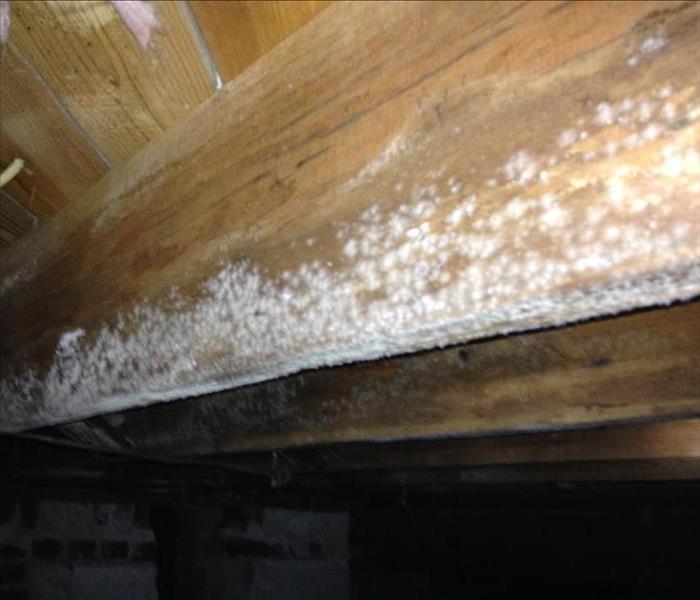 Mold in Crawl Space
Mold in Crawl Space
When was the last time you checked out your crawlspace?
If you haven’t inspected your crawlspace in a while you probably should, and check it regularly as well. At any time you could have water damage in your crawlspace and never know it. People often think that their crawlspace is just dirt, and the water will simply absorb into the ground. Often, this is true. But larger amounts of water, continuous leaks, or high bentonite content in the soil (common in Casper) could mean that it will not dry out on its own quickly. With saturated soil and standing water, high humidity can develop in the crawlspace. If that humidity condenses on the underside of the subfloor and flooring joists, secondary damage can occur. If these porous materials stay wet, mold can grow. With its lack of sunlight and air flow, a crawlspace is a perfect environment for microbial growth.
If you check your crawlspace and see any suspected microbial growth, give SERVPRO a call. We will come out and do a free inspection. We will review the steps that need to be taken to bring your crawlspace back to a safe state. Call SERVPRO of Casper today for your free assessment at 307-235-6558.
Mold Clean Up
6/8/2018 (Permalink)
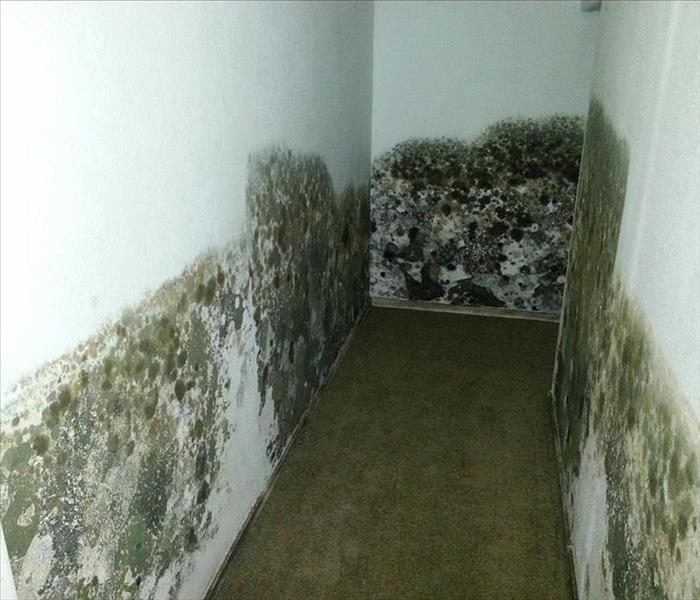 Moldy Drywall
Moldy Drywall
Mold damage on a water loss
A lot of different materials in your home can be affected by water damage, and some of these materials can grow mold if not taken care of right away. Here are a few examples:
Drywall:
The paper backing on drywall is organic, and is susceptible to mold growth. Humidity and moisture in a structure can aggravate the growth of mold. Drywall that is contaminated by mold has to be cut out and removed properly, to keep any spores and hyphal fragments from spreading.
Wood Framing:
Because wood is a purely organic material, mold can quickly form and colonize on it. This is especially true of framing that is covered by drywall. The lack of light and airflow inside a wet wall cavity creates optimal conditions for mold growth. Once moldy drywall is removed, some mold growth on the wood framing can be expected. It is important that the mold is properly removed from the framing, and that the framing is properly dried, before new drywall is installed.
Carpet:
Modern carpets are made almost exclusively of synthetic materials. While synthetic materials are not a viable food source for mold, the carpet face, backing, and pad normally have dust trapped in or under them. This dust (dead skin cells, pet dander, etc.) can support mold growth. Carpet and pad can hold a lot of water, so it’s important to begin water removal quickly. If there is mold on the carpet, just like on drywall, properly removing carpet and pad and treating the subfloor will help prevent further spreading of spores. After structural drying is complete, new carpet and pad can be installed.
If you encounter any mold in your home, call SERVPRO of Casper at 307-235-6558 today. We can send a certified technician to inspect the damage, and guide you through the steps to remediate it properly.
Food Mold Growth
5/4/2018 (Permalink)
 Moldy Food
Moldy Food
How can you minimize mold growth? Cleanliness is vital in controlling mold. Mold spores from affected food can build up in your refrigerator, dishcloths, and other cleaning utensils.
- Clean the inside of the refrigerator every few months with 1 tablespoon of baking soda dissolved in a quart of water. Rinse with clear water and dry. Scrub visible mold on rubber casings using 3 teaspoon of bleach in a quart of water.
- Keep dishcloths, towels, sponges and mops clean and fresh, a musty smell means they’re spreading mold around. Discard items you can’t clean or launder.
- Keep the humidity level in the house below 40%.
How can you protect food from mold?
- When serving food, keep it covered to prevent exposure to mold spores in the air. Use plastic wrap to cover foods you want to stay moist – fresh, or cut fruits and veggies, and greens and mixed salads.
- Empty opened cans of perishable foods into clean storage containers and refrigerate them promptly.
- Don’t leave any perishables out of the refrigerator more than 2 hours.
- Use leftovers within 3-4 days so mold doesn’t have a chance to grow.
How should you handle food with mold on it? Buying small amounts and using food quickly can help prevent mold growth. But when you see moldy food:
- Don’t sniff the moldy item. This can cause respiratory trouble.
- If food is covered with mold, discard it. Put it into a small paper bag or wrap it in plastic and dispose in a covered rash can that children and animals can’t get into.
- Clean the refrigerator or pantry at the spot where the food was stored
- Check nearby items the moldy food might have touched. Mold spreads quickly in fruits and vegetables.
PPE
1/31/2018 (Permalink)
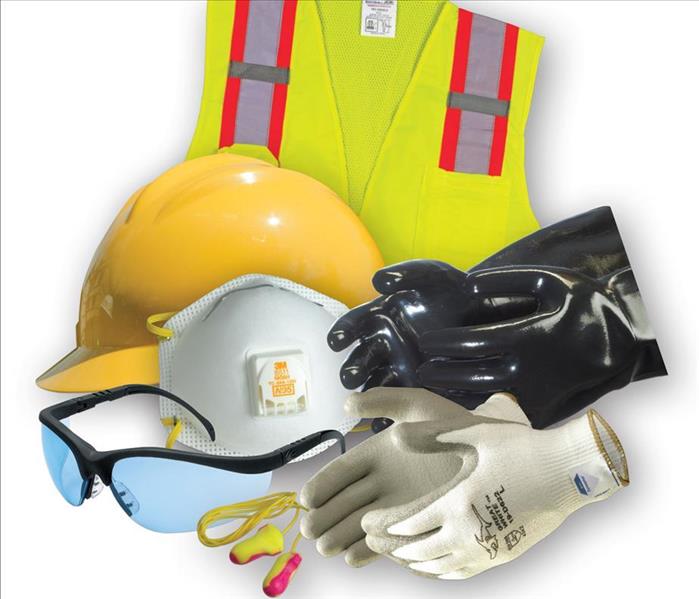 Images of the different types of Personal Protective Equipment.
Images of the different types of Personal Protective Equipment.
Personal Protective Equipment (PPE)
When dealing with mold remediation, it is critical to wear the appropriate PPE (Personal Protective Equipment). Protection of the respiratory system, eyes, and skin is important during mold removal tasks. Depending on the type of job or the specific kind of job site (such as industrial shops), it may be necessary to wear additional protective equipment. These environments can have inherent hazards that require additional protection, such as safety-toed boots, metatarsal protection, and hard hats.
Some of the different types of PPE are:
- Hard hat for overhead impact or electrical hazards
- Eye protection with side shields, or protective goggles
- Gloves chosen for job hazards expected (e.g., heavy – duty leather work gloves for handling debris with sharp edges and/or chemical protective gloves appropriate for chemicals potentially contacted)
- ANSI-approved protective footwear
- Respiratory protection as necessary—NIOSH N95 face pieces may be used for nuisance dusts (e.g., dried mud, dirt and silt). NIOSH P100 respirators are typically used on mold projects to protect against airborne contaminants. Filters with an activated charcoal layer may be used for nuisance odors.
Its best to let the professionals take care of your mold clean up. The professionals at SERVPRO of Casper have the knowledge and training to remediate mold damage safely and effectively.
Mold Clean Up
7/11/2017 (Permalink)
 SERVPRO of Casper specialize in mold clean up.
SERVPRO of Casper specialize in mold clean up.
There is a common misconception that when a homeowner finds black mold in their home, that they “have the black mold”. They believe that it is mold from the Stachybotrys genus (as made infamous in various news reports), but that’s not always the case. There are over 250,000 different species of mold that have been identified by scientists, and the color of the mold is not a reliable indicator of its species.
Regardless of the specific type of mold that is present, the handling and cleanup procedures remain the same. There are 7 easy steps to safe, successful mold removal:
Step 1 – Call a professional company that has been trained and has Applied Microbial Remediation certification through the IICRC.
Step 2 – Inspection and Mold Damage Assessment – a thorough inspection to determine the extent of mold presence. In some situations, it may be necessary to have testing performed by a Certified Industrial Hygienist. They are the professionals that are qualified to perform scientific mold testing. An Industrial Hygienist will write a remediation protocol after testing. It is essentially a “playbook” with their recommended steps to properly address the mold problem.
Step 3 – Mold Containment – A containment with negative air pressure is set up in the contaminated area. This prevents the mold spores from spreading to other areas in the building.
Step 4 – Air Filtration – HEPA filters are used as part of the negative air pressure system. These filters capture the mold spores out of the air.
Step 5 – Removing Mold and Mold-Infested Materials – Certain contaminated materials, such as drywall, are bagged and disposed of. Mold is removed from wood framing and other surfaces through a variety of methods, including HEPA vacuuming, sanding, and cleaning.
Step 6- Cleaning Contents and Belongings – Your personal belongings are evaluated, and handled item-by-item. Some items may not be restorable, and will need to be disposed of. Others can be cleaned using antimicrobial products, HEPA vacuuming, or possibly laundering.
Step 7 Restoration – Once the mold has been removed and cleaned up, the property can be put back together. We have multiple contractors in the Casper area that specialize in restorative construction.
If you think you have mold in your home or office, feel free to give SERVPRO of Casper a call at 307-235-6558. We have highly-trained staff that is certified through the IICRC, and ready to help you. We can make the mold problem in your home or commercial building “Like it never even happened.”




 24/7 Emergency Service
24/7 Emergency Service








